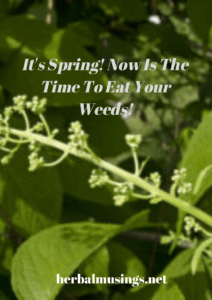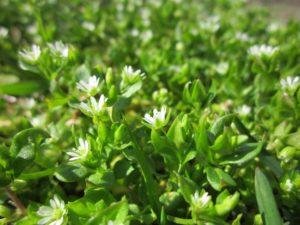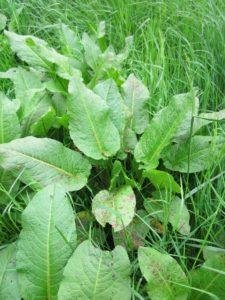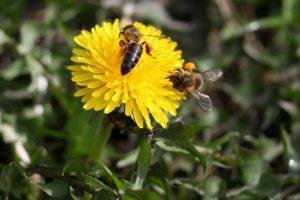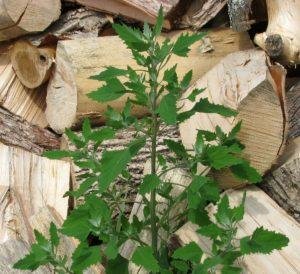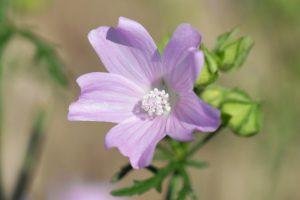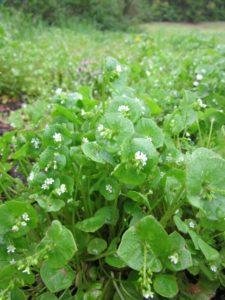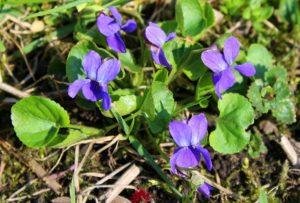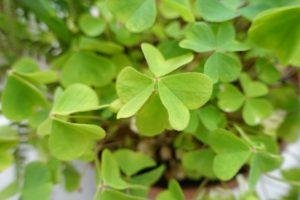Embrace the wild and eat your garden weeds! While some foraged weeds may be an acquired taste, you may be pleasantly surprised at how tasty the wild plants in your backyard really are. They also have a surprising amount of nutritional and health benefits and the best part is they’re totally free! I love having weeds in my yard!
Chickweed (Stellaria media) is a delicate plant often growing in sprawling mats and has a mild green flavor. It wilts quickly, so eat the tender leaves, stems, and flowers as soon as possible after picking. Chickweed contains calcium and vitamin C and tastes best eaten raw in dishes that highlight its freshness such as salads, sandwiches, juices and pesto.
Curly dock or yellow dock (Rumex crispus) are both related to rhubarb, sorrel, and oxalis. Harvest the tender, somewhat sour young leaves before they get tough. Dock is high in vitamin C, iron and calcium. They are eaten raw in salads or steamed, boiled or sautéed like other leafy greens. You can also make dock chips similar to kale chips.
Dandelion (Taraxacum officinale) is very nutritious and eaten raw or cooked much like you would use greens such as kale or chard. Young leaves offer the mildest flavor and are a gourmet salad green. More mature leaves are bitter but bitterness is actually beneficial for the digestive system. They’re a good source of vitamin C, vitamin K, potassium and calcium. The bright yellow flowers are edible and have more beta-carotene than carrots. Add them to salads, fry them or ferment into a fruity wine. Harvest the roots, dry, roast and brew them for a coffee substitute.
Lamb’s quarters or white goosefoot (Chenopodium album) is calcium and protein-rich food that tastes like spinach. Eat this any way you would eat spinach. New shoots and tender leaves are especially tasty raw while the larger leaves taste better cooked. Lamb’s quarters is a good source of several vitamins and minerals. One serving has more than the recommended dose of vitamin A and K and has significant amounts of magnesium and calcium.
Mallow (Malva neglecta, M. parviflora) are a good source of minerals, calcium, and magnesium. They also contain potassium, iron, selenium and vitamins A and C. This mild-flavored plant has a mucilaginous quality a bit like okra. Eat the tender leaves raw in salads and smoothies or steamed, boiled or sautéed like spinach. The leaves make a soothing tea for dry sore throats and coughs. The flowers make a pretty, edible garnish. All parts of the mallow plant are edible; the leaves, the stems, the flowers, the seeds, and the roots.
More Spring Weeds
Miner’s lettuce (Claytonia perfoliata) helped prevent miners from getting scurvy, this vitamin C packed green is mild and succulent. Miner’s lettuce is best enjoyed fresh, whether you nibble it on the spot or eat it in a salad or sandwich. It is pleasingly crunchy, mild-tasting has large leaves and remains tender even when in flower. According to a study in the Journal of the American Dietetic Association, 100 grams of miner’s lettuce contains a third of your daily requirement of vitamin C, 22 percent of vitamin A and 10 percent of iron.
Mustard (Brassica spp., particularly B. rapa, B. nigra) greens are nutritious and spicy and can be cooked just like cultivated leafy greens. Young leaves have a better texture and milder, less bitter flavor. The flowers are also pleasantly spicy and make a good garnish. Garlic mustard greens are very nutritious as they have substantial amounts of vitamins A, C, E and some of the B vitamins. In addition, this wild weed contains potassium, calcium, magnesium, selenium, copper, iron and manganese as well as omega-3 fatty acids.
Stinging nettle (Urtica dioica) is so nutritious, I can’t get enough of them! I eat the young leaves steamed, I dry the taller stalks so I can make infusions in the winter. I have nettles all year round. Harvest nettles before they flower and use gloves, scissors and tongs to avoid touching them directly. If you come in contact with nettles, you will immediately know by the stinging you feel. If this happens look for plantain, a common weed. Chew a leaf of plantain making a poultice and rub this on the area that’s stinging, this plant will relieve the pain. Nettles are great for relieving allergies! Nettles are rich in vitamins and minerals.
Violet (Viola sororia) has a mild flavor and is rich in vitamin C. The flowers make a beautiful garnish for salads, pancakes, and desserts. Use them raw or candied. The tender new leaves are eaten raw or cooked like spinach. Be aware that yellow violets may have laxative properties. I enjoy violet leaves and flowers in salad, pesto and in sandwiches and wraps. The leaves and flowers along with dandelion young leaves and flowers make a great salad.
Wood sorrel (Oxalis stricta) has heart-shaped leaflets and flowers that are high in vitamin C and have a refreshing lemony sour taste. I enjoy eating wood sorrel when I’m out in my gardens and in salads. Eat the leaves raw in salads, compound butter, juices, and garnishes. The juice can also be used to make lemony sauces and dressings.
Here’s a post I wrote about foraging wild edible weeds and their benefits for more info.
I’m excited to have all this food abundance around my yard and in the fields. Will you eat some weeds this spring? Let me know in the comments below which ones you like.
